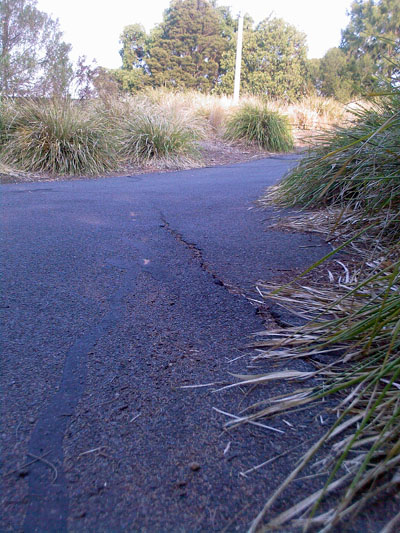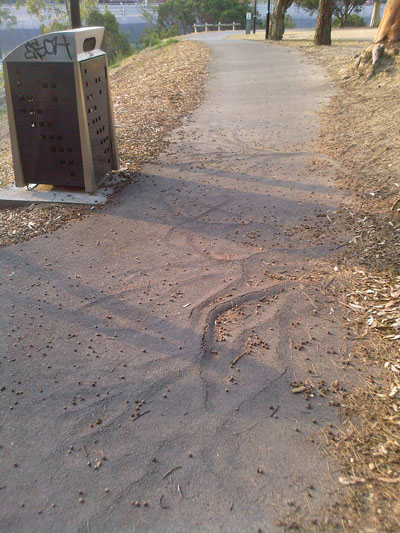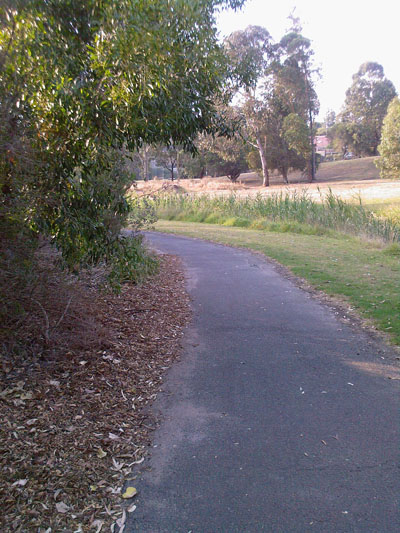So I rode just over 10km on the Scotchmans Creek Trail, then turned around and headed back to my starting point. But I returned straight along Waverley Road, which runs parallel. In other words, I rode out along the meandering bike path and back by the straightest route possible.
How much extra distance did the bike trail add? What do you think? As little as 100 metres? 500 metres? 1km? Maybe 2km?
I was expecting it to be about 0.5–1km at the most. To my surprise it was 2.4km longer to travel by the bike trail—that's 30% extra distance over the shortest route.
And despite the road route being hillier, my average speed was faster riding on the road as well.
What's going on here? Why is the trail so much longer? And why is riding on the trial so much slower?
In a discussion on cyclists' rights to use the road, Bicycle Victoria covers many of the relevant points:
3. The disadvantages of riding on shared paths
In Melbourne we also have a network of shared paths through parkland and along waterways which are fantastic for people walking the dog, bike riding families, kids riding to school and recreational cyclists. Shared paths are wider than a footpath and bicycles can legally use them…
However shared paths are less useful for utility cyclists who are trying to get to work, other destinations or training. On shared paths cycle speeds are slower, the route is often less direct, and the space is shared with walkers, dogs, rollerbladers, skateboarders, prams and scooters.
But there's more. Many trails, including the Scotchmans Creek Trail, are in a pretty poor state. Despite what BV says, for much of its length the Scotchmans Creek Trail is not noticeably "wider than a footpath", and its edges are often cracked:

It's also frequently lumpy and cracked:

And, my personal favourite, it has numerous blind corners:

All of this adds up to a slow ride.
Not that there's anything wrong with that. For all its faults, I rather enjoy the Scotchmans Creek Trail and often use it when I want to take a short trundle of 5–10km before dinner.
But I don't use it if I want to get somewhere. That is, if I'm cycling for transport—if there's a destination to be reach or an errand to be run—I'll take the road, just like everyone else who has somewhere to go.
Get off the road
We often hear the complaint, "Why don't cyclists get off the road and use the bike path?" A reasonable question, you might think. After all there's a dedicated off-road bike path.
Let's flip that question around. Why doesn't the motorist take the freeway? After all, that's a dedicated motor vehicle "path". The simple answer is that the freeway doesn't always take the motorist where s/he wants to go. And in heavy traffic, it might even be quite slow.
And it's the same for the cyclist. No one wants to take a route that's going to add 30% to the distance and make you travel slower.
But then, there are times when we want to slow down and take the scenic route. That's what recreational bike trails are perfect for.
Build it
It's good to see some clear distinction being made between recreational cycling and cycling for transport, as Harry Barber was quoted recently in The Age:
"In the past, bike plans have been muddled because they tried to be a recreational plan or a bike tourism plan," he said. "But we want this to be a transport plan for bikes."
Possibly, BV could be pushing for the kind of bike planning that David Hembrow refers to as The Grid:
Back in the 1970s the Netherlands went through a period of research into what works for promoting cycling…One of the conclusions reached was that good quality cycle routes are of no use if they're not close together…It was concluded that good quality cycle paths should be a maximum of 500 m apart.
Melbourne is a long way from that and would need some vision, similar to that seen in Portland:
Since the mid-1990s Portland, Oregon has pursued a "build it and they will come" strategy by developing its bikeway network to promote increased bicycle use. Between 1992 and 2005 Portland increased its developed bikeway network by 215%, from 83 miles to 260 miles. During this same period, bicycle use in Portland soared. A comparison of 1990 and 2000 census data shows a doubling of bicycle commute trips citywide, with more dramatic increases in close-in neighborhoods.
Taking it seriously
Karl has also been giving this topic thought recently, posting a straw poll on whether people prefer to ride on roads or off-road cycle paths:
Every single one of them said off-road cycle paths. So here we have a bunch of responsible adults, who're keen enough to either get jobs teaching others how to ride bikes on the roads…yet not one of us would actually want to ride on the road, given the choice.
Why? Many of the reasons have to do with the relatively poor condition of bike trails but ultimately: "They never seem to connect to anywhere useful".
What it comes down to is that if bike trails are not taken seriously as transport corridors, they simply don't form part of the transport network. In another post, Hembrow spells it out clearly:
We've got recreational trails too, and they are very pleasant for "going for a ride", but they're not really part of the practical network in the city here either.
Comments
Nicely put; and helping to explain why I find the bike paths so tempting and so annoying all at once. It's tempting to be off the road, and by the river, but they aren't a good way to get anywhere quickly, and your average speed is always lower than on the road I find. I prefer bike lanes on existing roads, and by that I mean solid white line division along the entire road (Auburn Rd is quite good) not a stenciled white picture of a bike on the road every 2k!
The Scotchman's creek path between East Malvern and where it ducks under the Mulgrave/SouthEastern/Monash/ThisWeek'sName Freeway is totally unusable. Its bumpy, unmaintained, has blind corners and wanders all over the place like a drunk stumbling home. Its totally non-viable as a transport path, and that doesn't even take into account random chunks of it disappearing when roadworks happen.
I actually prefer the roads to ride on - they are straight and maintained (Glen Eira council notwithstanding), and you're travelling with the traffic a lot of the time. The only bike path I regularly use is from East Malvern along Gardiner's creek - and only because its flatter than riding along Princes Hwy.
I just noticed something similar on my commute home yesterday, which is usually along the Eastern Freeway track, from Heidelberg to Mitcham. I need to go a bit out of the way to get on to the track safely. Instead I took safe roads all the way home, saved about 3.5km (18.5 versus 22) and had a higher average speed. Plus less danger from pedestrians, dogs and oncoming cyclists.
The Eastern Freeway track meanders significantly compared to the freeway itself (particularly up and down). The Eastlink trail is even worse.
A piece of tarmac walks into a bar. He orders himself a cold one and spots a pretty piece of green asphalt sitting alone at a table. So he leans over to the barman and says: give her one more of whatever she is drinking. I would be careful if I were you mate, says the barman. She is a bit of a cycle-path.
Gro-oan. "You should send that in to the Reader's Digest. They've got a page for people like you."
Well spotted eccles—all of the photos were taken along that section of the Scotchmans Creek Trail.
Don't get me started on the Eastlink Trail—the stretch through the Mullum Mullum valley is 100% not a transport route: too windy, too hilly.
I rarely ride the Eastern Freeway Trail for transport purposes, but I think some of it's OK and some of it is meandering and narrow. As I recall, there aren't too many blind corners (at least, compared to other trails) but Hamish is dead right about it being a bit more up and down than the adjacent freeway.
I ride to work on a bike path, prefer it over the road but the blind corners do bother me. Scared one day I will get caught out. Sometimes the blind corner could easily be fixed just be removing a couple of bushes.